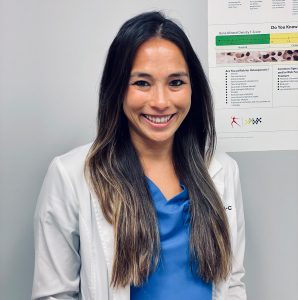A Critical Need: Making the Case for PAs in Rheumatology
Lindsay Tom, PA-C
June 15, 2022
 Rheumatology is an often-overlooked specialty that serves a vital role to patients with autoimmune diseases, osteoarthritis, and osteoporosis. Collectively, these diseases affect more than 24 million people in the United States.1 In addition, the U.S. population is now living longer, with an average life expectancy of 77 years of age according to recent reports from the CDC.2 With an aging population comes an increased number of comorbidities associated with age, including osteoarthritis and osteoporosis.
Rheumatology is an often-overlooked specialty that serves a vital role to patients with autoimmune diseases, osteoarthritis, and osteoporosis. Collectively, these diseases affect more than 24 million people in the United States.1 In addition, the U.S. population is now living longer, with an average life expectancy of 77 years of age according to recent reports from the CDC.2 With an aging population comes an increased number of comorbidities associated with age, including osteoarthritis and osteoporosis.
Left untreated and under-treated, rheumatology conditions can lead to devastating consequences, including severe pain and joint or organ damage, that are irreversible if quick action is not taken. Due to advancements in the medical field and pharmacology, there are now a wide range of new and approved medications to help treat these challenging disease states. With these advancements, conditions that were previously debilitating or life-threatening can now be managed at an outpatient rheumatology office. While this is truly remarkable, the benefit to patients is limited if they cannot get into a rheumatology office to receive the proper workup and treatment.
The importance of the field of rheumatology is clear. The challenge comes with the fact that despite the increased need for rheumatology providers, there has been a decrease in the number of new physicians choosing this specialty. This gap leads to patient suffering. Patients often wait 2-3 months to see a specialist who can treat their rheumatology condition. During that time, they not only experience pain, but also lose valuable time that could be spent treating their condition and preventing progression and severe complications.
This is not a new problem; however, despite outreach efforts, there has not been enough action to bring new rheumatology practitioners into the field. In 2015 the American College of Rheumatology Workforce Study reported concerns about the decreased number rheumatologists. In an article initially published in August 2020, Dr. David Borenstein noted that “the prevalence of doctor-diagnosed arthritis was 52.5 million in 2012. In 2030, 67 million patients will have rheumatic disease. Over this period of time the number of time adult rheumatologists will go from 5,595 to 4,246.”3
Medscape published an article in January 2021 expressing similar concerns.4 This is alarming for the population. There are discussions of adding more fellowship programs for physicians entering this specialty, and while this may be helpful in the future, it does not address the problem at this very moment.
The effects of rheumatological conditions are far-reaching and critical. While many people associate rheumatology with the treatment of rheumatoid arthritis and lupus, there are other autoimmune conditions that are also treated in this specialty, as well as osteoarthritis and osteoporosis.
Osteoarthritis cannot be reversed; however, some medications and joint injections can provide more comfort to patients and help restore their quality of life. Furthermore, differentiating between osteoarthritis and inflammatory arthritis is not always straightforward and often requires workup from a rheumatology practice.
Osteoporosis is another condition seen more frequently in an aging population, and it is extremely important that it be treated. It is often a silent disease, with no true symptoms showing until subsequent fragility fractures occur as a result of the underlying condition. As medical providers, we have the ability to decrease the likelihood that fractures and secondary issues will occur by screening and aggressively treating osteoporosis. Rheumatology providers play an essential role in helping with this care.
This is where PAs can play a critical role in filling the gap in rheumatology care. The 2020 NCCPA Statistical Profile of Certified PAs by Specialty reports that only 0.3% of PAs practiced in rheumatology in 2020.5 This equates to ~360 PAs in the country choosing this specialty. This is exceptionally low, particularly for a specialty that is in demand and in need of more providers.
As a PA practicing in this field, I know that PAs can make a huge impact to patients and society by choosing to practice in rheumatology. Increasing the number of rheumatology PAs will provide patients with further access to care in a timely manner, in a field in which time truly makes a difference. Our MD colleagues must complete a residency and fellowship after medical school. In contrast, PAs have the ability to transition into specialties immediately after graduation. Furthermore, we can switch specialties as we see fit for our careers and lifestyle. I see this flexibility in PA practice as an opportunity to quickly fill the void and address the shortage of providers in rheumatology.
As a current PA in rheumatology, I have found a love for this field. My daily schedule is quite busy and always full of surprises. I see a combination of both new and established patients with a wide range of conditions, from osteoporosis and osteoarthritis to rheumatoid arthritis, psoriatic arthritis, ankylosing spondylitis, gout, lupus, myositis, vasculitis, and everything in between. As an outpatient provider, I work Monday through Friday, with occasional time on call. I have found working in rheumatology to be extremely fulfilling and rewarding.
While I treat some of my patients for a short-term period of time, many have chronic illnesses requiring lifelong care. I am able to establish a relationship with each of my patients and truly improve their quality of life. I have found my calling as a PA in rheumatology, and hope that by sharing the importance of this field and advocating for PAs in rheumatology, others will choose to go into this specialty as well.
If you have any further questions for me, feel free to contact me at [email protected]. For more information on getting involved in rheumatology, check out and engage with the Society of PAs in Rheumatology.
References
- National Institutes of Health – The Autoimmune Diseases Coordinating Committee. Progress in Autoimmune Diseases Research. https://www.niaid.nih.gov/sites/default/files/adccfinal.pdf
- (2021, October 12) National Statistics. Centers for Disease Control and Prevention. https://www.cdc.gov/arthritis/data_statistics/national-statistics.html
- Borenstein, David MD. (2021, September 20). Hug Your Rheumatologist: The Shortage is Coming. The Arthritis Connection. https://www.thearthritisconnection.com/rheumatoid-arthritis/hug-your-rheumatologist-the-shortage-is-coming
- Monga, Kanika MD. (2021, January 05). Rheumatology Shortage Threatens Arthritis Care. Medscape. https://www.medscape.com/viewarticle/943438#vp_2
- (2021). 2020 Statistical Profile of Certified Physican Assistants by Specialty. https://www.nccpa.net/resources/nccpa-research/#all-reports

